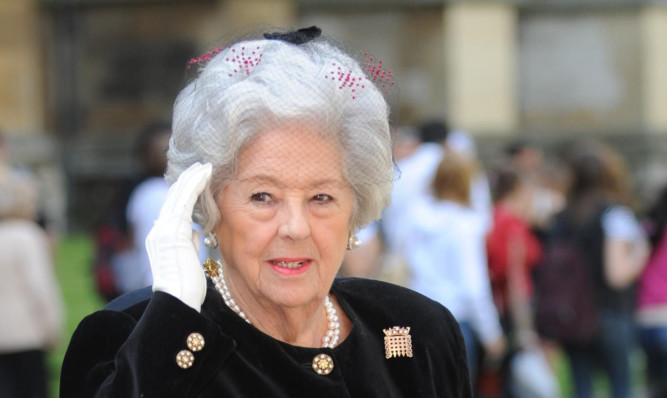
Former Speaker warns the party faces meltdown if they go into coalition with Scottish National Party.
Betty Boothroyd has rubbished the idea of Labour going into coalition with the SNP after May’s General Election.
The former Speaker of the House of Commons, still one of the most respected voices in Westminster, says “leading lights” from Labour have told her a coalition would not be tolerated. And she’s warned the party would face meltdown if they relied on the Scottish Nationalists to govern as MPs and Labour Lords would tear up their memberships in protest.
Now a peer as Baroness Boothroyd, she rarely intervenes publicly in politics, 15 years after stepping down as the Commons’ first female Speaker. However that means when she does, her comments are taken seriously.
Speaking on BBC Parliament’s Laws And Ladies programme, Baroness Boothroyd said: “If you get Labour almost elected, in need of a coalition, and they go in with the SNP, I’m afraid a lot of Labour members, ordinary paid-up members, and members of the Lords and Commons will float away from Labour.
“They have fought tooth and nail to get a No vote in the referendum, they’ve given blood in the referendum. Labour won that vote.
“People have talked to me about it, leading lights, they are not going to tolerate Labour moving in with the SNP, after having given blood like they did in that referendum.”
Baroness Boothroyd sits as a crossbencher in the House of Lords as she was required to give up her party allegiance when she became Speaker in 1992.
However she retains close links with her former party.
As the last Speaker not to be tainted with controversy her successor Michael Martin was toppled by his handling of the expenses scandal and current Speaker John Bercow is in a battle to appoint a new clerk to run parliament she remains an influential figure.
In the same interview the one-time Tiller Girls dancer dismisses election debates as “a big yawn” and is scathing about Prime Minister’s Questions.
However it’s her comments about the prospect of a coalition after the May 7 vote that will attract most attention.
Last week an unnamed Labour MP warned “public figures” would leave the party rather than sit alongside the SNP on the government benches.
However there’s a difference between an off the record rant and a stateswoman like Baroness Boothroyd speaking with the input of Labour’s “leading lights”.
Labour, still favourites to win the General Election according to the polls, have been sending out mixed messages on the issue of coalition.
Last month Shadow Chancellor Ed Balls appeared to categorically rule out doing a deal with the SNP. Scottish Labour leader Jim Murphy has only said he “doesn’t want” a coalition. And last week Shadow Scottish Secretary Margaret Curran dodged questions on the issue insisting she was “categorically fighting for a majority government”.
The reason most Labour figures aren’t ruling out doing a deal with the SNP is the polls still point to a major shift in power north of the border.
Top Scottish Labour figures who were still hopeful of delivering the vast majority of their seats a few weeks ago, are now looking at the electoral maths and claiming Ed Miliband can make it to Downing Street without them if he makes enough gains in England and Wales.
The optimism that greeted Jim Murphy’s rise to the leadership in Scotland has given way to familiar grumbles about London Labour and Scottish Labour failing to work together effectively. Their pessimism is driven by one of the few certainties of the forthcoming election that the SNP will emerge with significantly more than the six seats they currently hold.
The leadership hope to hold the balance of power in a hung parliament. First Minister and party leader Nicola Sturgeon spent the Scottish Parliament recess on a charm offensive.
In a set piece speech in London she strongly hinted at the price she’d demand for supporting a Labour administration halting the replacement of the Trident nuclear deterrent and postponing or reversing austerity. The two are not unrelated.
Cash saved on Trident could be diverted to anti-austerity measures. The question is how she would get her way.
For while Labour publicly refuses to talk about coalition, the SNP’s only hope of getting into government is to team up with their erstwhile foes. That could be via a formal pact or a “confidence and supply” arrangement, believed to be the SNP’s preferred option, under which the junior partner only promises to back budget measures and guarantees their support in the event of a vote that could bring the Government down.
Having ruled out supporting a Tory administration it’s intriguing to project how coalition negotiations would play out.
There’s the question of who would lead the SNP negotiating team. It’s unlikely Alex Salmond would want to sit on the sidelines but Sturgeon won’t want to give the impression he’s still in the SNP driving seat.
And Labour may yet have the whip hand.
The SNP face an alternative between supporting a Miliband premiership or putting David Cameron back in Downing Street.
Labour would be quick to point to parallels with 1979 when the SNP triggered the vote of no confidence in James Callaghan’s Government that ultimately put Margaret Thatcher in power and saw the Tories rule for
18 unbroken years.
Betty Boothroyd ran the Commons for the last five years of majority Tory rule at a time when the Government had a wafer-thin majority and often relied on a sort of unofficial coalition with Northern Ireland’s unionists.
She knows what she’s talking about and now she’s above party politics her comments carry weight in the pre-election atmosphere.
Like this story? Tell everyone about it:

Enjoy the convenience of having The Sunday Post delivered as a digital ePaper straight to your smartphone, tablet or computer.
Subscribe for only £5.49 a month and enjoy all the benefits of the printed paper as a digital replica.
Subscribe